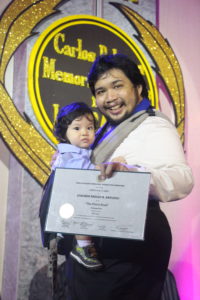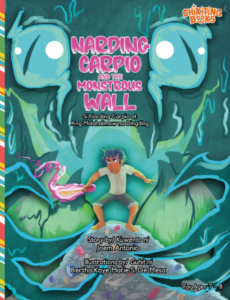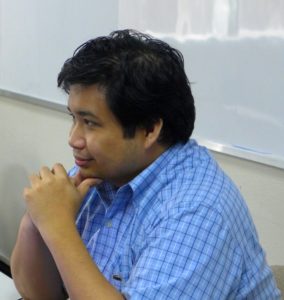It’s time to introduce your children (and yourself too!) to mythology with a local flavor. Meet Narding Carpio.
Eight-time Palanca winner and UA&P Humanities Program Director Dr. Joachim Emilio “Joem” B. Antonio makes a legendary figure in Philippine mythology known for his extraordinary strength more relatable to children with Narding Carpio and the Monstrous Wall. Read on as we chat with Doc Joem—now a father of three—about his family, his new book, and his writing projects.
Congratulations to you and your wife, Joy, for the newest addition to the family! What’s the baby’s name, and how are the two older children coping with a new baby in the house?
Thank you so much! Her name is Carmelita Joy Antonio, Callie for short. Geen is quite doting towards her while Leroy is pretty cool about it.
Did the pandemic change any of your family’s routines? How did the children take the quarantine?
It did, a lot and frequently. The most glaring change is that work and family space has become indistinguishable. Since the pandemic caught us in the middle of Joy’s pregnancy, the routines had to change frequently due to preparing the house for the baby, finding ways to minimize going out for supplies, and then having to adjust again once the baby was born.
The kids, thankfully, adjusted well. They’re quite happy having me around the whole day. Sometimes Geen even wants to be part of my Zoom meetings. If there’s anything Geen misses is accompanying me when I do the groceries.
Your hands are full with family and work duties. Where do you get the time to write? Is there a favorite spot for writing?
It’s not so much about getting time as it is making opportunities for writing. Even before the pandemic, finding opportunities to write has always been difficult. Thankfully, through some years of research and experimentation, I’ve developed a few techniques and practices that allow me to optimize the three- to five-minute windows I find every day.

During the pandemic, however, I had to develop a system. I do my brainstorming while I do my chores and errands. I do most of my actual writing on my phone. I use the time it would have taken to set up and pack away the laptop to get writing down. It’s good that, by this time, the kids are used to seeing me writing, so now I get to use my computer again. From time to time, they do ask me to draw, so that, then, becomes my “break.”
As for a favorite spot for writing, I don’t have the luxury for it at the moment. But I am generally thankful for even that single sentence that I’m able to write for the day.
Narding Carpio and the Monstrous Wall is your third children’s story, right? When did you start writing it, and where did you get the inspiration?
If by children’s story, we’re referring to the ones published by the big local publishers, then yes, it’s my third. I actually wrote it way back in 2009, soon after the Ondoy disaster. It was, in a way, my process of coping with the flood back then, even though, admittedly, we were far from the worst. When Chikiting Books opened a call for submissions, I reviewed this old story, updated it, then submitted it. After a decade of the story going nowhere, it finally got published.
Can you tell us briefly what the story is about? What do you want children to learn from it?
In broad strokes, it’s about Barangay San Geronimo getting submerged under enormous waves and the local hero Narding Carpio comes to their rescue. Aside from the expected message of taking care of the environment, I felt that this story also serves as a gateway to introduce children to the legend of Bernardo Carpio.
Have your children read this story? What did they say about it?
There was a time during the editing and layout process of the book where I got to read the story to them almost every night. I suppose they like it enough.

Narding Carpio and the Monstrous Wall is recommended for children ages 7-8 years old. What books were you reading at age seven?
Hmmm… I’ve had a wide taste back then. I remember having read Michael Ende’s The Neverending Story, a bit of Greek Mythology, and eight out of Nick Joaquin’s Pop Stories for Groovy Kids series. I’ve also had my share of Asterix, Tintin, The Smurfs, and some other books.
Each of your first two published children’s stories won for you a Palanca Award. This year’s CPMA* has been cancelled, but would Narding Carpio have been an entry to the Palanca?
Well, Narding Carpio has been an entry of mine two to three times in the past, and it has lost repeatedly. I actually wrote a different children’s story for this year’s Palanca to keep my writing practice up to date.
What’s next on your writing agenda?
Since the start of the pandemic, most of my writing has been geared towards transforming my writing workshops to fit the online platform. Since March, I’ve typed down over 15 of my workshops and, by this time, I’ve already written over 200,000 words, not including occasional dabbles at poetry and some speeches and memos I had to deliver. A bit of rest would be good.

Then again, I still plan to write a few more exesanonymous.com monologues, possibly more poems and more workshops and, possibly, a few more children’s stories. I am presently interested in exploring alternatives to the traditional publishing route, especially now with the pandemic having a lot of implications and impact on the publishing industry.
Are your writing workshops ongoing?
Yes, they are. We’ve adapted the workshops to the online platform. They’re largely self-paced and asynchronous and, surprisingly, they’ve taught me a lot of what can be done when teaching during these times. Fingers crossed, hopefully what I’ve learned will work with my students for this semester as well.
If the readers want to know more about the workshops, where can they go?
For the writing workshops, they can check out https://www.storywritingschool.com/. If they want to inquire about the AB Humanities with specialization in Creative Writing that the Humanities offers, they may email [email protected].#
*The Don Carlos Palanca Memorial Awards (CPMA) for Literature, or the Palanca Awards, is considered the most prestigious literary awards in the Philippines.
Banner photo by BAILEY MAHON on Unsplash.
Leave a Reply